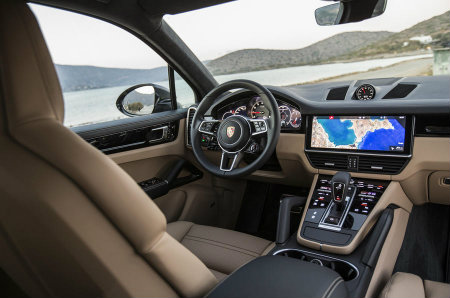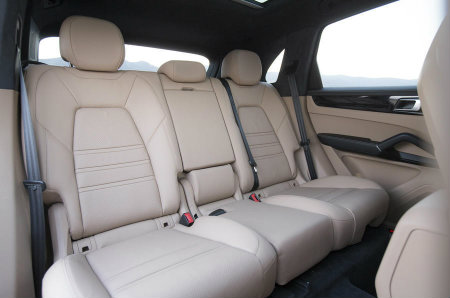At first, when you take a peek at the new Porsche Cayenne, it would be hard to distinguish what changes the manufacturer has implemented into the third generation. Nevertheless, this is what the average Porsche customer would see, however, there are some high-tech and driver experience improvements made from the previous model.
When the first Porsche Cayenne came out in 2002 – Porsche created a unique combination of performance and handling, whilst providing SUV practicality. As the years have passed, we’ve seen the likes of the Range Rover Sport in 2004, the BMW X5 M, Bentley Bentayga and we are waiting for the upcoming Lamborghini Urus. So, can the new Porsche Cayenne make its mark in the SUV market once again?

Porsche Cayenne – Driving
The performance of the new Porsche Cayenne is incredible, even the entry-variant gets a 3.0-litre 335bhp turbocharged V6 – this accelerates it from 0-60mph in less than six seconds. As you take off in low engine speeds, it does pull strongly, however it does start to feel strained at the top of the rev range.
If you were to choose the Cayenne S, the V6 is slightly smaller with it being 2.9 litres – despite this fact, with the extra turbo involved, this means it takes a second shorter to reach 60mph. However, when it comes to the top of trims – the Cayenne Turbo sits rightfully in its throne, as its mighty twin-turbo V8 gives off the performance which would have been the preserve of supercars only a few years ago. From its name, it immediately makes it apparent that this trim allows you to enjoy the thrills of the road. Although, be careful. You may reach the legal limit quicker than you anticipate.
This new Cayenne, Porsche have added a new chassis control system – 4D. This monitors a selection of sensors, feeding back to an active air suspension system to provide optimum responses to different types of terrains. The Cayenne comes with five different drive modes for you to test out, this was created as Porsche wanted to improve the off-road performance. Therefore, they’ve developed a mode for different settings such as gravel, mud, sand and rock – like the ability of the Bentley Bentayga.
In terms of handling the car, it has lost some weight, therefore bettering the driver capability to truly handle the Cayenne on the road – this applies to all the models. We previously mentioned the different driving modes that come with the new Cayenne, with the air suspension in “Comfort” mode, it feels keen to turn in to corners and resists roll very well. When you decide, you want to switch to “Sport” mode, this will firm things up as it enables the Cayenne to be agiler.
The performance of the new Porsche Cayenne is incredible, even the entry-variant gets a 3.0-litre 335bhp turbocharged V6 – this accelerates it from 0-60mph in less than six seconds. As you take off in low engine speeds, it does pull strongly, however it does start to feel strained at the top of the rev range.
If you were to choose the Cayenne S, the V6 is slightly smaller with it being 2.9 litres – despite this fact, with the extra turbo involved, this means it takes a second shorter to reach 60mph. However, when it comes to the top of trims – the Cayenne Turbo sits rightfully in its throne, as its mighty twin-turbo V8 gives off the performance which would have been the preserve of supercars only a few years ago. From its name, it immediately makes it apparent that this trim allows you to enjoy the thrills of the road. Although, be careful. You may reach the legal limit quicker than you anticipate.
This new Cayenne, Porsche have added a new chassis control system – 4D. This monitors a selection of sensors, feeding back to an active air suspension system to provide optimum responses to different types of terrains. The Cayenne comes with five different drive modes for you to test out, this was created as Porsche wanted to improve the off-road performance. Therefore, they’ve developed a mode for different settings such as gravel, mud, sand and rock – like the ability of the Bentley Bentayga.
In terms of handling the car, it has lost some weight, therefore bettering the driver capability to truly handle the Cayenne on the road – this applies to all the models. We previously mentioned the different driving modes that come with the new Cayenne, with the air suspension in “Comfort” mode, it feels keen to turn in to corners and resists roll very well. When you decide, you want to switch to “Sport” mode, this will firm things up as it enables the Cayenne to be agiler.
 Porsche Cayenne – Exterior
Porsche Cayenne – ExteriorThroughout the new Porsche Cayenne, it has a contemporary feel to it. It’s both longer and lower than the previous Cayenne, but still, the five-door profile is unmistakable. Its classic Porsche Cayenne characteristics remain; with its 911 inspired headlamps, a long swooping bonnet with power dome, and the trio of large air intakes, the rear has been also more comprehensively revamped.
Porsche, however, has implemented a few exterior changes, including a full-width light strip with LED taillights, but overall the Cayenne’s body is more broad-shouldered and has a muscular feel, making it appear very alike to the Panamera.
The Porsche Cayenne is a big car, therefore you can expect it to take up most of the road. With it being 4,918mm long, 1,696mm high and 1,983mm wide, it has similar dimensions to the Range Rover Sport.
Porsche Cayenne – Interior
When it comes to the new Porsche Cayenne’s interior, it is profound with its appearances, as its inspired by the latest Panamera saloon. Although, all changes made have been courteous of the driver; as there’s a wide, low-profile dashboard with a big 12-inch touchscreen at its centre, while the multifunction steering wheel sits in front of a classic Porsche instrument binnacle.
Porsche Cayenne – Interior
When it comes to the new Porsche Cayenne’s interior, it is profound with its appearances, as its inspired by the latest Panamera saloon. Although, all changes made have been courteous of the driver; as there’s a wide, low-profile dashboard with a big 12-inch touchscreen at its centre, while the multifunction steering wheel sits in front of a classic Porsche instrument binnacle.
 If you’re familiar with the older Cayenne, you’ll be happy to know Porsche have kept the large central rev counter, but a pair of high-resolution displays flanking it can be configured by the driver to display instruments, maps and other important information which can be found at your convenience.
If you’re familiar with the older Cayenne, you’ll be happy to know Porsche have kept the large central rev counter, but a pair of high-resolution displays flanking it can be configured by the driver to display instruments, maps and other important information which can be found at your convenience.In terms of tech, the Porsche Advanced Cockpit is new to all Cayenne variants and introduces a glass-effect panel at the centre of the console with touch-sensitive buttons, so you’re able to control major car functions easily. You are also presented with a Porsche Communication Management system – this sits above with its high-definition 12-inch touchscreen, and with Porsche Connect, this enables you to have Apple CarPlay connectively and numerous apps for your own enjoyment.
 We’re pleased to say the space in this car is great and caters to all big and small – even the tallest of passengers have plenty of space above their heads and there’s also a lot of legroom for both front and rear seats (these are both comfortable may we add!). However, the only negative we have to say is there isn’t the same sensation of spaciousness with front-seat occupants that compare to more upright SUV models.
We’re pleased to say the space in this car is great and caters to all big and small – even the tallest of passengers have plenty of space above their heads and there’s also a lot of legroom for both front and rear seats (these are both comfortable may we add!). However, the only negative we have to say is there isn’t the same sensation of spaciousness with front-seat occupants that compare to more upright SUV models.The boot is an impressive 745 litres for the least spacious Turbo model, whilst the entry-level model can accommodate up to 1,710 litres with the rear seats folded down.
To conclude, the new Porsche Cayenne is a great car for you if you’re in the search for a model that has a powerful engine, flexible rear seats and sharp handling. However, it can be expensive to run and if you love your tech, you may be disappointed. Nevertheless, the Cayenne is a people pleaser!
For more CarCliq reviews click here
For more CarCliq reviews click here
Looking for a used Porsche Cayenne? Click here